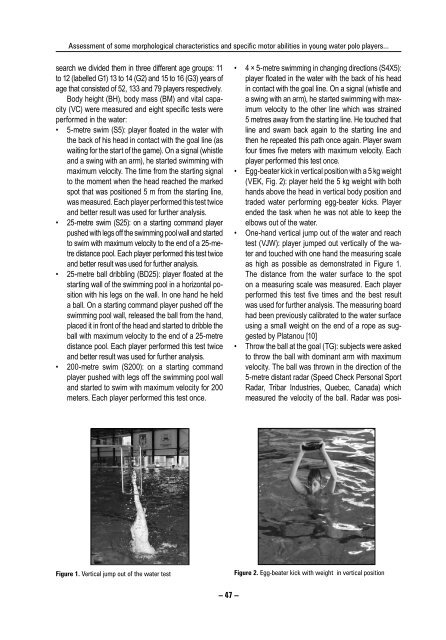Antropomotoryka nr 51 - Akademia Wychowania Fizycznego w ...
Antropomotoryka nr 51 - Akademia Wychowania Fizycznego w ...
Antropomotoryka nr 51 - Akademia Wychowania Fizycznego w ...
- No tags were found...
You also want an ePaper? Increase the reach of your titles
YUMPU automatically turns print PDFs into web optimized ePapers that Google loves.
Assessment of some morphological characteristics and specific motor abilities in young water polo players...search we divided them in three different age groups: 11to 12 (labelled G1) 13 to 14 (G2) and 15 to 16 (G3) years ofage that consisted of 52, 133 and 79 players respectively.Body height (BH), body mass (BM) and vital capacity(VC) were measured and eight specific tests wereperformed in the water:• 5-metre swim (S5): player floated in the water withthe back of his head in contact with the goal line (aswaiting for the start of the game). On a signal (whistleand a swing with an arm), he started swimming withmaximum velocity. The time from the starting signalto the moment when the head reached the markedspot that was positioned 5 m from the starting line,was measured. Each player performed this test twiceand better result was used for further analysis.• 25-metre swim (S25): on a starting command playerpushed with legs off the swimming pool wall and startedto swim with maximum velocity to the end of a 25-metredistance pool. Each player performed this test twiceand better result was used for further analysis.• 25-metre ball dribbling (BD25): player floated at thestarting wall of the swimming pool in a horizontal positionwith his legs on the wall. In one hand he helda ball. On a starting command player pushed off theswimming pool wall, released the ball from the hand,placed it in front of the head and started to dribble theball with maximum velocity to the end of a 25-metredistance pool. Each player performed this test twiceand better result was used for further analysis.• 200-metre swim (S200): on a starting commandplayer pushed with legs off the swimming pool walland started to swim with maximum velocity for 200meters. Each player performed this test once.• 4 × 5-metre swimming in changing directions (S4X5):player floated in the water with the back of his headin contact with the goal line. On a signal (whistle anda swing with an arm), he started swimming with maximumvelocity to the other line which was strained5 metres away from the starting line. He touched thatline and swam back again to the starting line andthen he repeated this path once again. Player swamfour times five meters with maximum velocity. Eachplayer performed this test once.• Egg-beater kick in vertical position with a 5 kg weight(VEK, Fig. 2): player held the 5 kg weight with bothhands above the head in vertical body position andtraded water performing egg-beater kicks. Playerended the task when he was not able to keep theelbows out of the water.• One-hand vertical jump out of the water and reachtest (VJW): player jumped out vertically of the waterand touched with one hand the measuring scaleas high as possible as demonstrated in Figure 1.The distance from the water surface to the spoton a measuring scale was measured. Each playerperformed this test five times and the best resultwas used for further analysis. The measuring boardhad been previously calibrated to the water surfaceusing a small weight on the end of a rope as suggestedby Platanou [10]• Throw the ball at the goal (TG): subjects were askedto throw the ball with dominant arm with maximumvelocity. The ball was thrown in the direction of the5-metre distant radar (Speed Check Personal SportRadar, Tribar Industries, Quebec, Canada) whichmeasured the velocity of the ball. Radar was posi-Figure 1. Vertical jump out of the water testFigure 2. Egg-beater kick with weight in vertical position– 47 –





![Antropomotoryka nr 57 [2012]. - Akademia Wychowania Fizycznego ...](https://img.yumpu.com/50213388/1/182x260/antropomotoryka-nr-57-2012-akademia-wychowania-fizycznego-.jpg?quality=85)










